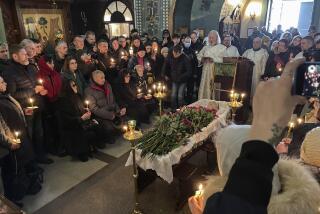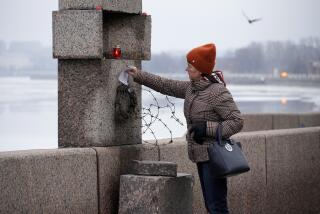Russia Brings Exiled Empress Home to Rest
- Share via
MOSCOW — Empress Maria Fyodorovna, the Danish-born mother of Russia’s last czar, was reburied Thursday next to her son and husband in the Romanov family crypt in St. Petersburg nearly eight decades after her death in exile.
Russian Orthodox Patriarch Alexei II presided over the day’s pomp-filled ceremonies, which were attended by hundreds of domestic and foreign dignitaries, including members of various branches of European royalty and about 50 Romanov descendants.
“This will be another sign that Russia is overcoming the enmity and divisions brought by the revolution and civil war,” Alexei said in a televised funeral service at St. Isaac’s Cathedral in the old imperial capital. “Having fallen deeply in love with the Russian people, the empress devoted a great deal of effort for the benefit of the Russian fatherland. Her soul ached for Russia.”
The morning ceremony was followed by afternoon burial with a second service at a church at the St. Peter and Paul Fortress, now the final resting place for every czar and czarina beginning with Peter the Great, who ruled from 1682 to 1725.
“This is a happy moment, that my great-grandmother is moving from Denmark to our country, to Russia,” Michael Romanov, who lives in Paris, said in televised remarks. He said this was his third visit to his “motherland.”
Alexei earlier described the return of the empress’ remains for honored reburial as “a great historic and spiritual event for Russia” that should be viewed as “an act of repentance on the part of society and the state.”
The last czar, Nicholas II, was executed by Bolshevik revolutionaries in 1918, along with his wife, Alexandra, their five children and four servants. His mother fled to Denmark in 1919 and died there in 1928, never having accepted that they were dead.
Nine charred skeletons were dug up from a burial pit near Yekaterinburg in 1991. DNA tests eventually identified them as those of the czar and czarina, three of the children and the servants. Those bones were reburied in the St. Petersburg crypt in 1998.
The remains of the other two children have never been found. According to accounts by the executioners, the two smallest corpses were burned to ash at the grave site and scattered.
The future empress was born in 1847 as Princess Marie Sophie Frederikke Dagmar. Baptized a Lutheran, she took the name Maria Fyodorovna when she converted to Russian Orthodoxy before marrying the future Alexander III, who reigned from 1881 to 1894. She had been engaged in 1864 to marry Alexander’s older brother Nicholas, but he fell ill and died the next year. It was then arranged for her to marry Alexander, and they wed in 1866.
On Tuesday, her remains arrived in Russia by ship at the Baltic Sea port of Kronshtadt, exactly 140 years after she first came to the country. The remains were taken first to the czars’ summer residence of Peterhof.
Before her coffin was entombed Thursday, it was draped with the yellow banner of the imperial family. Alexei and members of the Romanov family sprinkled soil into the grave, and cannons fired a 31-salvo salute. To the sound of choir music and church bells, a white marble tombstone with a gilded cross was set into place, and white roses were presented in the empress’ memory.
Russian President Vladimir V. Putin played an important role in encouraging the reburial. However, he did not attend Thursday’s services, which were billed as cultural and religious rather than political events.
Leonid Sedov, a historian and researcher at the Levada Center, an independent polling agency, said the reburial could be a step toward “curing our nation’s still-shattered moral health.”
“I think the country can’t develop properly, in every sense, if there is no repentance for the sins of the past,” Sedov said.
At the other end of the spectrum, Anatoly Lukyanov, former chairman of the Soviet Union’s legislature and now an advisor to the Communist faction in the lower house of parliament, said he feared the reburial “may be used to portray their family as holy martyrs and throw more dirt at Lenin and Soviet history.”
“I am very much concerned with the tendency to paint the Soviet past as one huge black hole while painting the czar and his family only in rose colors,” Lukyanov said.
But Sedov said the process of reassessing Soviet views of the past still hadn’t gone far enough.
During the Soviet era, “the history of the Romanovs was presented only in black colors, and this stereotype is very much alive despite that fact that something has been done already to restore the true picture,” Sedov said. “Events like this reburial help unite the people by opening our eyes to pages of history that are still very cloudy and illegible for many.”
Times staff writer Sergei L. Loiko contributed to this report.
More to Read
Sign up for Essential California
The most important California stories and recommendations in your inbox every morning.
You may occasionally receive promotional content from the Los Angeles Times.










